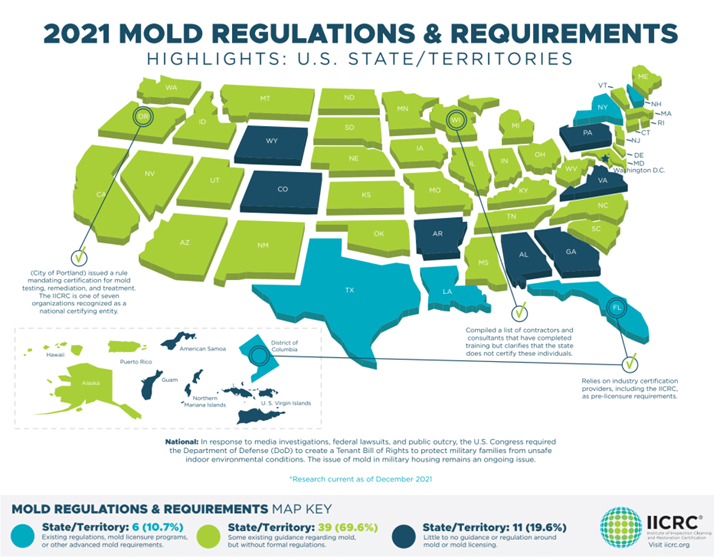The Millers – Part 4
We last left Sarah Miller shocked to learn that the basement of her home wasn’t the only problem area for her family. Her Indoor Environmental Profession (I.E.P.) had uncovered two additional areas of hidden mold and water damage.
In part 4, armed with a protocol and list of questions from her I.E.P., Sarah struggles in a way that many people who find themselves in this position do – trying to find a remediation company who would take her situation seriously and follow the protocol outlined by her I.E.P.

Part 4: The Remediation
Sarah felt defeated as she hung up the phone. Armed with a list of questions and protocol from her I.E.P., she had already called three out of the five names on her list of potential remediation companies.
Every phone call had included some version of “That’s not needed, we can just spray it” or “No need to follow your I.E.P.’s protocol because we’ve been doing it this way for 25 years and it works great for our clients.”
Sarah mumbled to herself, “Why is it so hard to find a good remediation company?”
Sarah’s I.E.P. had explained that remediation was not well regulated. A lot of what passes as remediation is inadequate and potentially unsafe.
Once again, her eyes scanned through the report from her I.E.P. The wet basement was just the beginning.
The I.E.P. had found two other areas of hidden water damage. These new areas showed high levels of Aspergillus, Penicillium, and Cladosporium molds. The basement came back positive for Stachybotrys, a toxic mold that is indicative of long-term water damage. Her heart broke.
Sarah thought of all the time her father, George, had been spending in the basement lately. The makeshift study she made for him after he moved in was meant to bring him comfort, not cause him health problems.
“No more shortcuts, no more quick fixes,” she thought. Too much was at stake.
Whatever happened next needed to be done correctly. And more importantly, safely.
Sarah didn’t realize it then, but her luck was about to change as she dialed the fourth remediation company on her list.
The next few weeks were a blur. The remediation company had been out to assess the problem areas and give her an estimate. They had agreed to follow the protocol outlined by her I.E.P. The contract was signed. The dates were set. Those few weeks were filled with a lot of fear, worry and second- guessing. But they were also filled with hope. Hope of a healthier home. Hope of a healthier family.
The night before remediation was set to begin, Sarah had been too nervous to sleep. She had already sent her kids and her father George to her sister’s house per the recommendation of her I.E.P. Ultimately, they had decided together it would best if no one was living in the home during remediation.
When the remediation crew finally arrived, Sarah went through the scope of the work with the lead technician. She wanted to make sure everyone was on the same page.
There were many details in the contract that answered key questions like…
Where will the containment go?
How will the proper pressure be established and monitored?
What protective gear will the crew be wearing?
How will damaged materials be removed safely from the containment?
How will HEPA vacuuming and damp wiping be performed?
What abrasive measures and chemicals will be used? (She was shocked to learn that she didn’t need harsh chemicals – this was about removal, not killing, covering, or fogging.)
How will the inside of the containment be cleaned after all the mold and water damaged was removed?
How will the rest of the home and belongings be cleaned including the HVAC and ductwork – the lungs of her home!
What will post-testing look like and what criteria would be used to determine if the remediation was successful?
The list went on.
When Sarah finally pulled out of her driveway later that morning, she hoped the next time she and her family returned they would be welcomed into a healthier home. A new beginning.
To be continued…
Stay tuned for part 5 when we reveal the outcome of Sarah’s remediation efforts.
-GET THE FACTS-
Mold Remediation is a bit like the Wild West!

Did you know mold remediation is not widely regulated in the United States?
Did you know there are currently no set standards for acceptable levels of mold by government health and environmental agencies?
This makes the mold remediation industry “The Wild West” of any industry performing scientific work.
There are a lot of practices that pass as “remediation” that don’t fully address the core problem and have the potential to be unsafe for you and your family.
Mold remediation is not about killing, fogging, or painting over mold and water damage.
It is about removing mold, water damage, and any other contamination safely so the home can return to having a healthy indoor environment.
We understand how challenging it can be to make decisions when faced with inconsistent and sometimes contradictory information from professionals and government agencies. We are here to help!
So how do you find a remediation company that implements the latest research-based practices and solves your mold and water damage problems safely and correctly the first time?
You can start by listening to our helpful interview with Michael Rubino, Co-Founder and President of Change the Air Foundation, Author of The Mold Medic: An Expert’s Guide on Mold Removal and Founder of HomeCleanse.Never miss an update! Join our newsletter and follow the Miller family as they begin to heal their bodies and their home.
